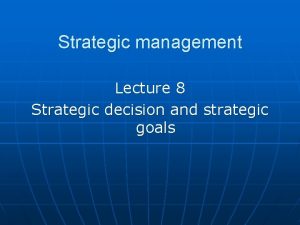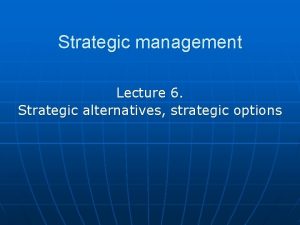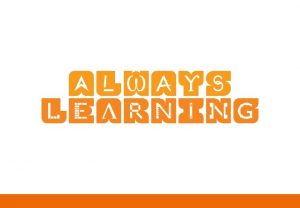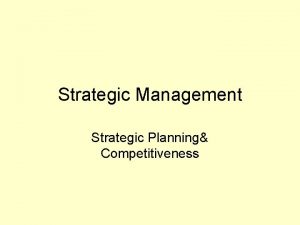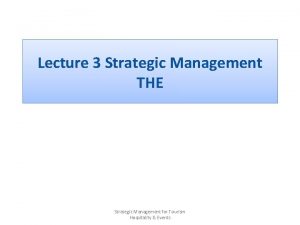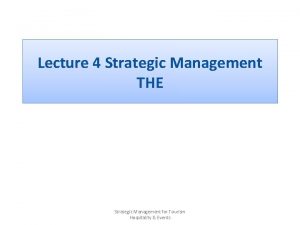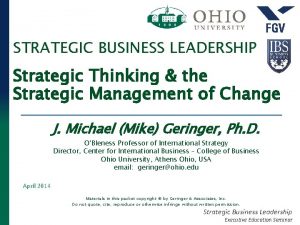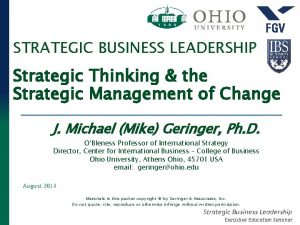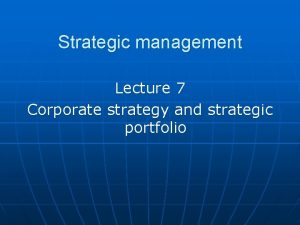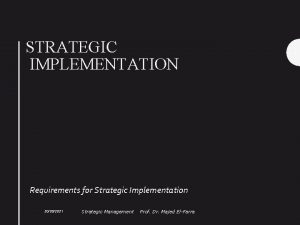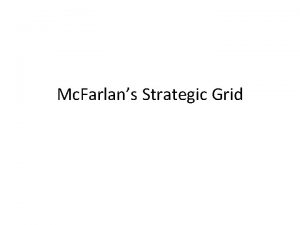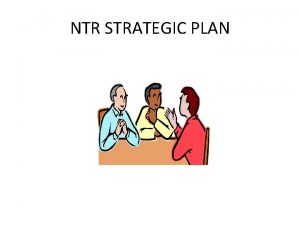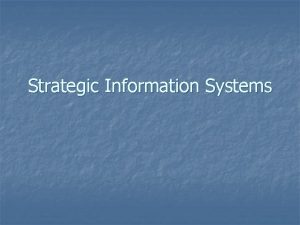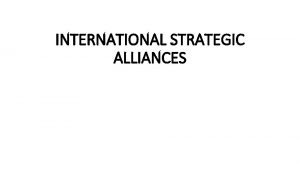Lecture 1 Strategic Management THE Strategic Management for



























- Slides: 27

Lecture 1 Strategic Management THE Strategic Management for Tourism Hospitality & Events

Mission – Vision – Goals What the organisation is trying to be and trying to achieve; • • require congruency and fit between levels; an overall enduring purpose – Mission; a desired future position – Vision; translating mission and vision into specific goals and objectives: – corporate objectives – business objectives – unit and personal objectives. Strategic Management for Tourism Hospitality & Events

Vision Mission Values • http: //hiltonworldwide. com/about/mission/ • http: //www. visitflorida. org/about-us/what-we-do/ • https: //investorrelations. lufthansagroup. com/en/fakten-zumunternehmen/group-strategy. html#c 10942 • http: //doc. rero. ch/record/255098/files/Rio_2016__Style_guide_final_january_2015. pdf

Internal analysis • • summary of study progress; purposes of internal analysis; components of internal analysis; the strategic process – where does internal analysis fit in? Strategic Management for Tourism Hospitality & Events

Summary of Study Progress Where have we got to? – an introduction to the subject matter; – establishing the THE context • Following we will analyse the internal aspects of organisations – their functional areas, which are considered in turn. – – operational competencies, resources and competitive advantage; human resources; financial resources; products and markets; • After that we will consider the external aspects of strategic analysis. Strategic Management for Tourism Hospitality & Events

Internal Analysis What’s the purpose? • internal analysis is concerned with providing the management of THE organisations with a detailed understanding of their organisations with respect to: – how effective current strategies are; – how effectively resources have been deployed in support of chosen strategies; • internal analysis – managers may gain insights and understanding of how competitive advantage might be achieved; • main techniques and frameworks which can be employed to enable THE managers to produce a comprehensive internal analysis of their organisation. Strategic Management for Tourism Hospitality & Events

Internal Analysis What’s the purpose? • THE organisations should carry out a robust and thorough internal analysis for a number of reasons, including: – to identify resources, competencies and core competences to be developed and exploited; – to evaluate how effectively value added activities are organised; – to identify areas of weaknesses to be addressed by the formulation of future strategies and their successful implementation; – to evaluate the performance of products; – to evaluate financial performance; – to evaluate investment potential if finance is being sought from external sources; – to assess the performance and future requirements for human resources; – to provide the analytical underpinning for the strengths and weaknesses section. Strategic of the SWOT. Management for Tourism Hospitality & Events

Internal Analysis Components • Internal analysis will usually cover some or all of the following aspects: – resource analysis; – competence identification and analysis; – internal activities analysis; – human resources and where gaps exist; – financial resources and financial performance; – products and their position in the market. Strategic Management for Tourism Hospitality & Events

Internal Analysis The strategic process – where does internal analysis fit in? STRATEGIC ANALYSIS Internal Analysis Current Strategies SWOT Key Issues (Strengths & Weaknesses) External Analyisis (Opportunities & Threats) STRATEGIC SELECTION STRATEGIC IMPLEMENTATION Evaluation of Options; selection of strategy Current Objectives Strategic Management for Tourism Hospitality & Events Implementation and management of the chosen strategy

Tourism, Hospitality and Event Organisations The Operational Context: Competencies, Resources and Competitive Advantage Strategic Management for Tourism Hospitality & Events

Introduction In this session: • • the sources of competitive advantage; resource analysis; competencies and core competencies; analysis outcomes; value adding activities; the service profit chain; service dominant logic. Strategic Management for Tourism Hospitality & Events

Competitive Advantage / Sustainable Competitive Advantage What is it? • Competitive advantage is often seen as the overall purpose of strategy. • In commercial settings it is traditionally viewed as returning higher profits than competitors. – Higher profits allow more to be retained to reinvest in its strategy, thus maintaining a lead over competitors. – When the superiority is maintained over time, sustainable competitive advantage is achieved. – To be sustainable the advantage must be able to resist the actions of rivals. Strategic Management for Tourism Hospitality & Events

Competitive Advantage / Sustainable Competitive Advantage BUT • In THE settings the traditional view is not necessarily working – A lead over competitors is not the only goal in cooppetition in THE. – Sustainable competitive advantage is achieved not over time but by unique products and services in THE. – To be sustainable the advantage must be able to resist the actions of rivals outside the own network, but must support actions of other service providers within the own network. Strategic Management for Tourism Hospitality & Events

Sources of Competitive Advantage Why are some organisations more successful? • In strategy this is usually associated with achieving competitive advantage and faster growth than competitors. • Previously we stressed the importance of context, but other factors have to be considered in any context. Strategic Management for Tourism Hospitality & Events

Sources of Competitive Advantage How is competitive advantage achieved • The sources of achieving competitive advantage in any industry lie in: – the superior application of competencies (skills); – the deployment of superior resources (assets); – creating value for consumers. Strategic Management for Tourism Hospitality & Events

Resource Analysis Some resources are easier to analyse than others • Resources can be tangible or intangible. • tangible – obtained from outside organisations in resource markets in competition with others; • intangible – often developed within an organisation; – have a value (often difficult to quantify or even identify) which can be bought and sold in markets; • Relationships with resource suppliers can be a part of the organisation’s core competence. Strategic Management for Tourism Hospitality & Events

Resources in THE Are some resources free? • THE is different from most other industries in that free resources are often vital. – available freely with unlimited supply and not requiring a market to allocate them, e. g. air, sea and scenery; – have to be utilised carefully in a sustainable way; • All resources have competing demands. – If they are used in one way they cannot be used in another. Strategic Management for Tourism Hospitality & Events

Resources in THE Key resource considerations in THE • resource immobility; – Many resources that are used cannot be moved either in terms of place or time. • resource substitution; – often difficult to substitute one resource category with another; • resource conflict and competition; – often in conflict or competition with other users; • resource ownership and control; – utilise resources that are neither owned nor controlled. Strategic Management for Tourism Hospitality & Events

Resources in THE Some further considerations • seasonality of resource utilisation; – Many THE activities are highly seasonal. • low rewards for resources; – sometimes only able to offer relatively low rewards; • capacity; – resource capacity often constrained in some way; • time; – Consumers have to give up their scarce resource-time. Strategic Management for Tourism Hospitality & Events

Analysing Resources There are different ways • analysis by category; – physical, operational, human, financial and intangible resources; • analysis by specificity; – Resources can be specific or non-specific. • analysis by performance; – How do they contribute to internal and external measures of performance? – Organisations can internally and externally benchmark performance as to stimulate improvements. Strategic Management for Tourism Hospitality & Events

Competencies and Core Competencies What are you good at? • Competencies; – Attributes such as skills, knowledge, technology and relationships that are common among competitors in an industry; • Core competencies are attributes distinguished from competencies. – Performance is superior to industry average. – unique to the company; – more complex; – difficult to emulate (copy); – relate to fulfilling specific customer needs; – add greater value than competencies; – distinctive relationships with customers, distributors and suppliers; Strategic Management for Touri. Hospitality & Evandnts – superior organisational skills and knowledge.

Analysis Outcomes What does resource and competency analysis add to our understanding? • The aim of an analysis of resources, competencies and core competencies is to understand the: – nature of the resources on which the organisation depends; – nature and sources of particular core competencies; – need for adaptation of existing core competencies; – need for new core competence building; – potential sources of core competence based on resources and competencies; – need for core competencies to remain focused on customer needs. Strategic Management for Tourism Hospitality & Events

Value What is it and how can we add to it? • value – the difference in value of the product compared to the value of the inputs. It can be increased by: – charging customers a higher rate; – reducing costs below those of competitors; • clear links between value-adding activities, core competencies, competencies and resources; – resources form inputs to the value-adding activities; – Competencies and core competencies provide the attributes to carry out the value-adding activities. – Greater value will be added the more that core competencies can be added to activities. Strategic Management for Tourism Hospitality & Events

Resource Analysis Example Brand Value How to value a brand? • https: //www. youtube. com/watch? v=s. QLl. PC_al. T 8 Strategic Management for Tourism Hospitality & Events

Outsourcing Used by many THE organisations • outsourcing – entrusting some of an organisation’s activities to an external entity; • Organisations concentrate on core activities associated with core competencies. • Activities which are not regarded as core are outsourced. – Combined complementary core competencies add to competitive advantage for all collaborators. – Value chain analysis can identify where outsourcing might add greater value. Strategic Management for Tourism Hospitality & Events

Outsourcing Vertical integration – horizontal integration – outsourcing Fashions over time for THE organisations • What are advantages and disadvantages to own for instance Travel agency – tour operator – airline – hotel – transportation company – cleaning company – public refusal collection company – farm for meat production – etc. ? Strategic Management for Tourism Hospitality & Events

SUMMARY • THE organisations have try to configure and coordinate their operational resources and processes in such a way that they add value. • In so doing they achieve an advantage over competitors – competitive advantage. • In THE sustainable competitive advantage is important. • It is very important in the strategy to have a good understanding of the resources they have available to them and how these are used to create value. • Analysis indicates where strategy needs to focus. • It is also necessary to consider the potential for collaboration with suppliers, distributors and customers
 01:640:244 lecture notes - lecture 15: plat, idah, farad
01:640:244 lecture notes - lecture 15: plat, idah, farad Strategic management lecture
Strategic management lecture Resource based model
Resource based model Tows matrix
Tows matrix Kontinuitetshantering
Kontinuitetshantering Typiska drag för en novell
Typiska drag för en novell Nationell inriktning för artificiell intelligens
Nationell inriktning för artificiell intelligens Vad står k.r.å.k.a.n för
Vad står k.r.å.k.a.n för Varför kallas perioden 1918-1939 för mellankrigstiden
Varför kallas perioden 1918-1939 för mellankrigstiden En lathund för arbete med kontinuitetshantering
En lathund för arbete med kontinuitetshantering Personalliggare bygg undantag
Personalliggare bygg undantag Personlig tidbok
Personlig tidbok Anatomi organ reproduksi
Anatomi organ reproduksi Densitet vatten
Densitet vatten Datorkunskap för nybörjare
Datorkunskap för nybörjare Tack för att ni lyssnade bild
Tack för att ni lyssnade bild Hur skriver man en debattartikel
Hur skriver man en debattartikel Autokratiskt ledarskap
Autokratiskt ledarskap Nyckelkompetenser för livslångt lärande
Nyckelkompetenser för livslångt lärande Påbyggnader för flakfordon
Påbyggnader för flakfordon Formel för lufttryck
Formel för lufttryck Offentlig förvaltning
Offentlig förvaltning Kyssande vind analys
Kyssande vind analys Presentera för publik crossboss
Presentera för publik crossboss Jiddisch
Jiddisch Vem räknas som jude
Vem räknas som jude Treserva lathund
Treserva lathund Mjälthilus
Mjälthilus































